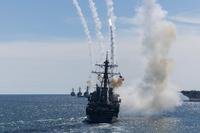A new safety investigation into one of the Navy's deadly 2017 ship collisions again highlights widespread problems with training, oversight and fatigue leading up to the accident that killed seven and hurt hundreds more.
The National Safety Transportation Board on Thursday matched many of the Navy's findings that the guided-missile destroyer Fitzgerald's crew failed to take action to prevent a collision with the ACX Crystal, a Philippine cargo ship, near Japan. The 50-page report from the agency tasked with investigating major accidents cites the bridge team's failures as the probable cause for the collision.
"The Fitzgerald bridge team, on the give-way vessel, did not take early and substantial action to avoid collision with the stand-on ACX Crystal," the report states.
Read Next: Badges and Beards: The Air Force Wants Your Ideas for Future Uniform Updates

The agency also found poor communication and cooperation between the bridge and combat information center contributed to the accident, along with insufficient planning ahead of the ship's transit through the hazardous area.
"Also contributing was the Navy's ineffective oversight of the Fitzgerald in the areas of operations scheduling, crew training, and fatigue mitigation," the report states.
Those are some of the same breakdowns the NTSB found contributed to a second fatal Navy ship accident just weeks later in 2017, when the destroyer John McCain collided with an oil tanker near the Singapore Strait, killing 10.
"This tragedy," Morgan Turrell, acting director of the NTSB's Office of Marine Safety, said of the Fitzgerald collision, "highlights the importance of keeping a vigilant watch, determining the risk of collision, and the role of the Automatic Identification System. If you are in doubt of another vessel's intentions, you need to use proper sound and visual signals, and then take early and effective action to avoid a collision."
The Fitzgerald and McCain collisions still loom over the Navy, but in the three years since the accidents, surface force training has changed dramatically, Cmdr. Clay Doss, a Navy spokesman at the Pentagon, said. There has been a renewed emphasis on seamanship, navigation and watch standing, he said.
The service has implemented dozens of changes after it identified more than 100 areas that needed attention after investigating the two tragic accidents. The NTSB's recommendations bolster some of those findings, Lt. Rob Reinheimer, another Navy spokesman at the Pentagon said.
"We appreciate NTSB's efforts to improve maritime safety by releasing reports like this," he said. "The Navy continues to mourn the deaths of seven USS Fitzgerald Sailors lost in the collision with ACX Crystal more than three years ago.
"[Of] the more than 100 recommendations from our own reviews, many already address the shortfalls indicated within NTSB's investigation and, in some cases, go beyond them," Reinheimer added.
Recommendations from the NTSB include:
- A call for review and revision of fleetwide training and qualification requirements for officers of the deck related to the collision regulations.
- Review and revision of bridge resource management training.
- The broadcast of automatic identification system information when in the vicinity of commercial vessel traffic, at all times, unless such broadcast could compromise tactical operations.
Navy ships were directed to turn on automatic-identification systems in high-traffic areas following the 2017 collisions. The Navy has also overhauled its ship navigation training and changed who can pursue surface-warfare officer qualifications.
"We learned a great deal from that tragedy by conducting our own Comprehensive Review and Strategic Readiness Reviews in late 2017," Reinheimer said. "We have applied those lessons aggressively to the way we train, operate and fight our ships throughout the surface fleet -- our Sailors sail confidently and safely every day."
-- Gina Harkins can be reached at gina.harkins@military.com. Follow her on Twitter @ginaaharkins.
Related: The Navy Is Making It Tougher to Earn a Surface-Warfare Officer Pin












